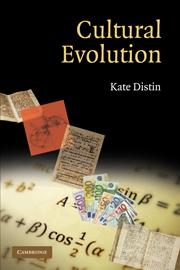Book contents
- Frontmatter
- Contents
- Cultural Evolution
- 1 Introduction
- PART I THE INHERITANCE OF CULTURAL INFORMATION
- PART II THE INHERITANCE OF CULTURAL INFORMATION
- PART III THE INHERITANCE OF CULTURAL INFORMATION
- PART IV THE RECEIVERS OF CULTURAL INFORMATION
- PART V THE EXPRESSION OF CULTURAL INFORMATION
- 12 Aspects of the Cultural Ecology
- 13 Patterns of Cultural Taxonomy
- 14 Conclusion
- Appendix
- Acknowledgements
- Bibliography
- Index
13 - Patterns of Cultural Taxonomy
Published online by Cambridge University Press: 05 June 2012
- Frontmatter
- Contents
- Cultural Evolution
- 1 Introduction
- PART I THE INHERITANCE OF CULTURAL INFORMATION
- PART II THE INHERITANCE OF CULTURAL INFORMATION
- PART III THE INHERITANCE OF CULTURAL INFORMATION
- PART IV THE RECEIVERS OF CULTURAL INFORMATION
- PART V THE EXPRESSION OF CULTURAL INFORMATION
- 12 Aspects of the Cultural Ecology
- 13 Patterns of Cultural Taxonomy
- 14 Conclusion
- Appendix
- Acknowledgements
- Bibliography
- Index
Summary
In addition to the ecological pressures that the previous chapter described, this chapter will argue that patterns of cultural taxonomy can be understood as the product of interactions between cultural information and its inheritance mechanisms. This mirrors the way in which patterns of biological taxonomy can be understood as the result of ecological pressures as well as of the interactions between genetic information and its inheritance mechanisms. The mechanisms that are responsible for the reproduction of genetic information have a significant impact on the spread and composition of biological populations: in nature, as the next section shows, the very concept of a species is affected by the ways in which different organisms reproduce. Because the mechanisms of cultural reproduction also vary, it seems reasonable to expect that they, too, will have taxonomic implications. This chapter explores the impact of cultural inheritance mechanisms on patterns of cultural diversity.
Biological Taxonomy
In sexual reproduction, genetic material from each parent is recombined and expressed in a new phenotype. The variation that is introduced by recombination is advantageous, but if too much variation were permitted then too many unviable individuals might be produced. For this reason, species boundaries limit the amount of genetic variation in each population (Bock 2004a: 180). Groups of interbreeding individuals are genetically isolated from other such groups by a variety of species barriers, including both physical and behavioural characteristics and gene-level factors.
- Type
- Chapter
- Information
- Cultural Evolution , pp. 200 - 219Publisher: Cambridge University PressPrint publication year: 2010



